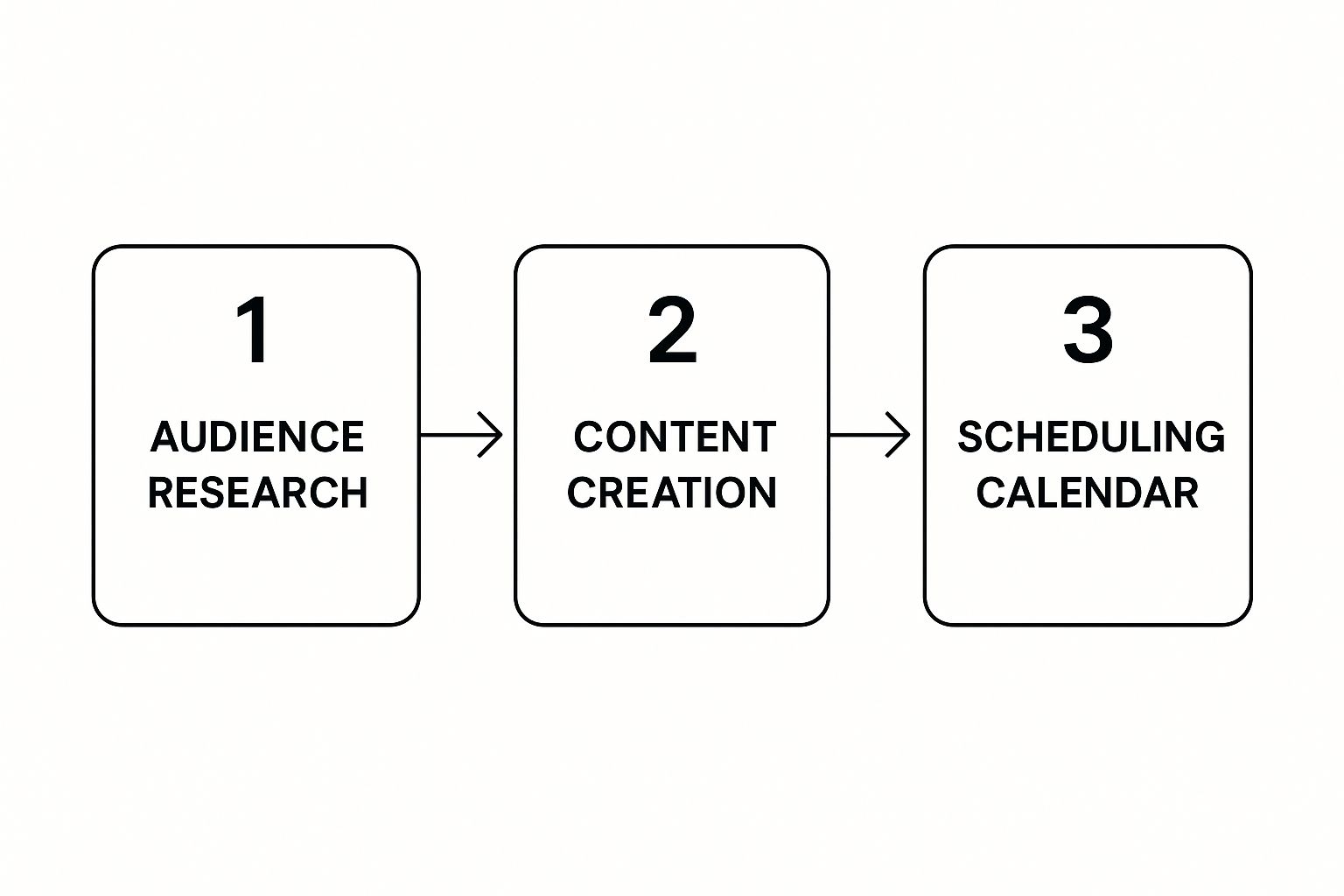Manage Marketing Campaigns Effectively | Proven Strategies

How do you Manage Marketing Campaigns Effectively?
To really get a grip on your marketing campaigns, you need to think beyond just switching on some ads.
It’s about building a solid, goal-focused plan from the ground up.
This means locking in your objectives, truly understanding who you’re talking to, and knowing what success looks like before you spend a single pound.
A well-managed campaign is strategic from day one, making sure every bit of your budget is working towards a real business outcome.
Building a Winning Campaign Foundation
Before you even start brainstorming ad copy or picking channels, you have to lay a strong foundation. Honestly, this initial planning stage is the single biggest decider of whether your campaign will fly or flop. It’s where you connect your marketing efforts to actual business goals, stopping you from throwing money down the drain on unfocused activity.
This foundation isn’t just a checklist. It’s a strategic framework that will guide every decision you make later on. We’re talking about moving past vague wishes like “get more traffic” and defining specific, measurable results that actually make a difference to your bottom line.
Define Your Core Objectives
What does a win really look like for this campaign? If you can’t answer that clearly, you’re just spending, not investing. Your objectives have to be bolted onto tangible business results.
Recent data from UK businesses shows a clear trend towards measurable outcomes. According to LOCALiQ’s 2025 UK State of Digital Marketing Report, a massive 54% of businesses see increasing sales revenue as their top marketing priority. Take a look at what UK businesses are concentrating on:
| Key Campaign Priorities for UK Businesses |
| :— | :— |
| Strategic Priority | Percentage of Businesses Focusing on It |
| Increasing sales revenue | 54% |
| Increasing brand awareness | 42% |
| Generating more sales leads | 36% |
| Reducing customer acquisition costs | 30% |
This table clearly shows that modern campaigns are expected to deliver real, quantifiable value.
To make your own objectives count, use the classic SMART framework:
- Specific: Nail down exactly what you want. Don’t just say “increase leads.” Say “generate 150 qualified leads for our new B2B software.”
- Measurable: Define your success metric. For example, “hit a £50 Cost Per Acquisition (CPA).”
- Achievable: Be realistic. Set a goal based on your budget, team, and what you’ve managed in the past.
- Relevant: Make sure the goal actually supports wider business aims, like launching a new product.
- Time-bound: Give yourself a deadline, such as “within the next 90 days.”
Key to Managing your Marketing Campaigns Effectively: Understand Your Audience Deeply
You can’t manage a campaign effectively if you don’t know who you’re talking to. And I don’t mean a generic profile. You need to build out detailed customer personas that feel like real people, complete with their own motivations, frustrations, and buying habits.
Let’s imagine you’re an ecommerce brand in the UK selling sustainable homewares. “Eco-conscious Emma” isn’t just a demographic. She’s a 34-year-old professional in Bristol who values brand transparency, reads environmental blogs, and is happy to pay more for ethically made products. This level of detail dictates everything—your messaging, the platforms you use, and the visuals you create.
If you’re running an online shop, getting these nuances right is vital. You might find our guide on mastering ecommerce PPC for UK digital marketers especially useful here.
A great customer persona goes beyond demographics. It captures the psychographics—the attitudes, values, and fears that drive purchasing decisions. When you understand what keeps your audience up at night, you can create marketing that offers a genuine solution.
Establish Your Key Performance Indicators
Your Key Performance Indicators (KPIs) are the specific metrics you’ll use to track progress towards your SMART goals. Think of them as your campaign’s vital signs. While your main goal might be to boost revenue, your KPIs are the early warnings that tell you if you’re on the right track or need to change course.
Choose KPIs that directly reflect your campaign objective.
- For brand awareness: Keep a close eye on Impressions, Reach, and Video View Rate.
- For lead generation: Your world revolves around Cost Per Lead (CPL), Conversion Rate, and maybe even a Lead Quality Score.
- For ecommerce: It’s all about Return on Ad Spend (ROAS), Average Order Value (AOV), and Customer Lifetime Value (CLV).
Picking the right KPIs from the start ensures you’re optimising for what really matters, instead of getting sidetracked by vanity metrics that look good but don’t grow the business. Nail this foundational work, and you’ll set the stage for a data-driven, successful campaign.
Smart Budgeting and Channel Selection
Think of your budget as your campaign’s fuel and your channel selection as the engine. Get this combo wrong, and you’ll burn through cash on platforms where your audience simply isn’t listening. Smart resource allocation isn’t about splitting your funds evenly; it’s about making deliberate, data-backed investments where they’ll deliver the biggest bang for your buck.
The first job is to land on a budgeting model that fits your business reality. Forget guesswork. A structured approach means every pound you spend is intentional, justifiable, and directly tied to the goals you’ve already set. This single decision will shape the scale and intensity of your entire campaign.
Choosing the Right Budgeting Model
There’s no magic, one-size-fits-all budget. What works for a high-growth startup is a world away from what a mature enterprise needs. The trick is to pick a model that brings clarity and lines up with your financial strategy.
Here are a few practical models we see UK businesses using all the time:
- Objective-Based Budgeting: This is the most strategic way to do it. You define a clear goal (e.g., “generate 200 qualified leads”) and then work backwards to calculate the cost. It forces you to connect every pound spent directly to a tangible outcome.
- Percentage of Revenue: A straightforward approach where you allocate a fixed slice of your total revenue (or projected revenue) to marketing. It’s simple and scales with your business, but it can be restrictive when sales dip, which is often when you need to invest more, not less.
- Competitor-Based Budgeting: This involves setting your budget based on what your rivals are spending. While it helps you maintain a competitive share of voice, it’s a risky game. You’re assuming your competitors actually know what they’re doing and that their goals are identical to yours.
Ultimately, the best budget is a flexible one. We always recommend starting with an objective-based model to ground your plan in results, but be ready to pivot. If a campaign is smashing its targets, you might want to pour more fuel on the fire sooner than you planned.
Matching Channels to Your Audience
Once your budget is locked in, the next big question is where to spend it. The temptation is to be everywhere at once, but trust me, a focused approach is far more powerful. Your customer personas are your roadmap here. Don’t chase trends; show up on the platforms where your ideal customers are already active.
Let’s look at two completely different UK business scenarios:
- B2B Tech Firm: Their persona is “IT Director David,” a 45-year-old decision-maker based in London. David isn’t scrolling through TikTok looking for software solutions. He’s on LinkedIn reading industry articles and on Google Search when he has a specific problem to solve. For this firm, putting the bulk of their budget into LinkedIn Ads and highly-targeted Google Search campaigns is a no-brainer.
- D2C Fashion Brand: Their persona is “Student Sophie,” a 21-year-old in Manchester. Sophie lives on visual-first platforms like Instagram and TikTok, discovering new styles from influencers and snappy video content. For this brand, the budget needs to be funnelled into Meta Ads (Instagram & Facebook) and TikTok campaigns that are all about eye-catching visuals and user-generated content.
Getting this channel selection right is absolutely vital for maximising your return. The UK advertising market is growing fast, with forecasts predicting it will hit a massive £43.1 billion in 2025—a 6.5% jump from the previous year. With that much money flying around, putting your budget in the wrong place is an expensive mistake. You can read more in the Advertising Association and Warc Expenditure Report.
Allocating your budget across these channels is more than just simple division. You also need to think about the bidding strategies you’ll use on each platform. Understanding how different bidding models work is key to controlling costs and driving up your ROI. For a deeper dive, check out our guide on choosing the right bidding strategy for maximum ROI. By aligning your budget, channels, and bidding tactics, you build a powerful, cohesive campaign that’s ready to launch.
Crafting Creatives That Actually Convert (Manage Marketing Campaigns Effectively)
With a solid strategy and budget locked in, it’s time for the fun part: making the ads. But don’t be fooled—effective creative is so much more than a pretty picture. It’s a careful mix of psychology, smart design, and punchy, direct-response copy. The real goal here isn’t just to interrupt someone’s scrolling, but to genuinely connect with them.
Think of your creative as the bridge between your entire strategy and a paying customer. It has to do the heavy lifting of stopping the scroll, showing its value in an instant, and convincing someone to act. When you manage marketing campaigns, nailing this is non-negotiable for a healthy Return on Ad Spend (ROAS).
Speaking Directly to Your Customer
Those customer personas you built? They’re now the blueprint for every single ad you create. You absolutely have to speak their language, hitting on their specific pain points and ambitions directly. Generic, one-size-fits-all messaging gets scrolled past; specific, empathetic messaging gets clicks.
Imagine you’re targeting “Startup Steve,” an ambitious founder in Manchester. He’s not thinking about “corporate synergy”—he’s losing sleep over cash flow and how to land his next ten customers. Your ad copy can’t be full of vague corporate jargon. It has to be direct and offer a real solution.
- Weak Headline: “Revolutionary Business Solutions for Growth”
- Strong Headline: “Stop Worrying About Your Cash Flow. Land More Clients Next Month.”
The second one works because it’s like you’re reading his mind. It names the pain point (worrying about cash flow) and dangles a clear, desirable outcome (more clients).
The Anatomy of a High-Converting Ad
Every single element of your ad has a job. From the headline down to the tiny call-to-action button, each part must work in harmony to guide the user toward your goal. If one part fails, the whole thing can fall apart.
Let’s break down the key components:
- The Hook (Headline & Visual): This is your first, and maybe only, chance to grab their attention. Your image or video needs to be visually arresting, and your headline must spark instant curiosity or make them nod in agreement. A picture of a business owner drowning in paperwork paired with the headline “Tired of Admin Chaos?” works because it’s immediate and relatable.
- The Body Copy (Persuasion): Once you’ve hooked them, the body copy has to quickly make your case. Use short sentences and bullet points. Focus on the benefits—how you solve their problem and make their life better—not just a list of features.
- The Call-to-Action (CTA): This needs to be a clear, compelling, and easy next step. Ditch the generic “Learn More” and try something specific and value-packed like “Get Your Free Quote” or “Download the Guide.”
And don’t forget, if your digital campaigns are supported by physical marketing, choosing effective custom promotional giveaways can be a great way to boost brand engagement and even conversions.
Embracing a Culture of Testing
Here’s a secret: great creatives are rarely born on the first try. They’re forged through relentless testing. Guessing is expensive, but a systematic A/B testing process lets you learn exactly what resonates with your audience, turning your ad account into a data-gathering machine.
You should never assume you know what will work best. The market is the ultimate judge, and the only way to get its verdict is to test. Even a small lift in conversion rate from a winning ad variation can have a massive impact on your campaign’s profitability.
Start by testing the big, bold ideas before you get lost in the weeds. Changing a button colour is fine, but it’s unlikely to move the needle as much as testing a completely different offer or a new core message.
Here’s a simple framework to get started:
- Test the Offer: “50% Off First Month” vs. “Free Consultation”
- Test the Headline: Benefit-led (“Save 10 Hours a Week”) vs. Pain-point-led (“Hate Wasting Time on Admin?”)
- Test the Visual: Product shot vs. Lifestyle image with people vs. Short video testimonial
- Test the CTA: “Shop Now” vs. “Get Your Discount”
This methodical approach is fundamental to successfully managing PPC campaigns. For more insights specifically for the competitive London market, check out our guide on mastering PPC campaigns with insider tips for London businesses. By building a repeatable system for creative development and testing, you move from hoping your ads work to knowing why they do.
Launching and Monitoring Your Campaigns
A successful launch isn’t a leap of faith; it’s an exercise in precision. After all the strategic work, the moment of truth arrives. But before you hit ‘go,’ a final pre-flight check is absolutely essential to prevent simple mistakes from torpedoing your entire effort.
The launch itself is just the beginning. The real work starts the moment your campaign is live, especially during the critical first 72 hours. This period sets the tone, giving you the earliest data on what’s working and what isn’t. Staying on top of this initial performance is key to making swift, informed decisions.
Your Pre-Flight Launch Checklist
Don’t rush to get your campaign live without a final, thorough check. A small oversight now can cause big headaches later. I’ve seen campaigns fail because a tracking pixel wasn’t firing correctly, meaning all the conversion data was lost from day one. It’s a painful and entirely avoidable mistake.
Before you launch, run through these essentials:
- Verify All Tracking: Are your Google Analytics 4 tags, Meta Pixels, and any other platform-specific tracking codes installed and firing correctly on your website and landing pages? Use browser extensions like the Meta Pixel Helper to confirm this.
- Test Your UTM Codes: Click through your own ad previews. Do the URLs populate correctly? Do the campaign, source, and medium parameters show up in your analytics in real-time reports? Broken UTMs muddy your data attribution.
- Review Landing Pages: Double-check every landing page linked from your ads. Make sure the headline matches the ad promise, all links work, forms submit correctly, and the page loads quickly. A slow or broken landing page will kill your conversion rate.
- Check Creative and Copy: One last look for typos, mismatched visuals, or incorrect offer details. Ensure every ad in every ad group points to the correct destination URL.
Think of this checklist as your pilot’s final cockpit check. It’s a disciplined process that ensures everything is configured for a smooth takeoff. Skipping it introduces unnecessary risk and undermines all the strategic work you’ve already done.
This systematic approach, shown in the flow below, highlights how organised processes—from research to scheduling—are the bedrock of a successful launch.
This process shows that a successful launch is the final step in a chain of well-organised activities, right from initial audience understanding to the final scheduling.
Monitoring Performance in Real-Time
Once you’re live, your focus shifts to monitoring. The goal isn’t to stare at your screen all day but to establish a rhythm of checking in that allows you to be responsive without overreacting to normal daily fluctuations.
To streamline your campaign launches and monitoring, consider implementing robust marketing automation strategies. These can help handle repetitive tasks and provide alerts for significant changes. For hands-on monitoring, build a custom dashboard that puts your most important KPIs front and centre.
Your dashboard, whether in Google Analytics 4, Meta Ads, or a third-party tool, should display the vital signs of your campaign at a glance:
- Spend: How much of the budget has been used? Are you on track?
- Impressions & Clicks: Is the campaign getting visibility and engagement?
- Click-Through Rate (CTR): Is your creative resonating with the audience?
- Cost Per Click (CPC): Are your ad auctions efficient?
- Conversions & Cost Per Acquisition (CPA): Is the campaign delivering on its primary goal at an acceptable cost?
Manage Marketing Campaigns Effectively: During the first 24-72 hours, check in more frequently—perhaps every few hours. You’re looking for major red flags: zero impressions (which could signal an approval issue), an unusually high CPC, or a CTR that’s practically zero. After this initial period, checking in once or twice a day is usually sufficient. This cadence gives you enough information to spot troubling trends early while giving the platform algorithms time to learn and optimise.
To keep everything on track, a simple checklist can make a world of difference. It ensures no stone is left unturned from the final checks to the first few days of monitoring.
Campaign Launch and Monitoring Checklist
This checklist will guide you through the crucial steps of launching and monitoring your campaigns to ensure a smooth start and effective ongoing management.
| Phase | Task | Status |
|---|---|---|
| Pre-Launch | Verify all tracking pixels are installed and firing | ☐ |
| Pre-Launch | Test all UTM parameters on ad links | ☐ |
| Pre-Launch | Review landing pages for errors and load speed | ☐ |
| Pre-Launch | Final proofread of all ad copy and creative | ☐ |
| Launch Day | Confirm campaign is active and approved | ☐ |
| Launch Day | Monitor real-time analytics for initial data | ☐ |
| First 72 Hours | Check KPIs (Spend, Clicks, CTR, CPA) every few hours | ☐ |
| First 72 Hours | Identify and address any immediate red flags (e.g., zero impressions) | ☐ |
| Ongoing | Establish a daily check-in routine | ☐ |
| Ongoing | Monitor budget pacing against daily/monthly targets | ☐ |
By following this checklist, you create a structured process that minimises risk and sets your campaign up for success from day one.
Optimising Performance and Scaling Success
Right, this is where a decent campaign becomes a great one. Optimisation isn’t a one-and-done job; it’s the constant process of turning raw data into smarter decisions that directly boost your return on investment. The launch is just the beginning—now you need to listen to what the numbers are telling you.
Interpreting metrics is all about understanding the story behind the data. This ongoing analysis is central to how you successfully manage marketing campaigns for long-term growth. It’s about moving beyond simple monitoring to making active, profitable tweaks.
Decoding Your Key Performance Metrics
Before you can optimise anything, you have to know what your metrics actually mean. Think of them as signals from the market, telling you what’s hitting the mark and what’s falling flat. A high Click-Through Rate (CTR) with a low conversion rate, for example, is a classic sign that your ad is grabbing attention but your landing page isn’t sealing the deal.
You’ve got to look at these metrics together to get the full story. A low Cost Per Acquisition (CPA) is fantastic, but not if the Customer Lifetime Value (CLV) of those new clients is also rock bottom. For a deeper dive into these crucial numbers, you can check out our detailed guide on mastering key metrics like CTR, CPC, and conversion rates.
The end goal is always to connect these performance indicators back to your bottom line. Return on Ad Spend (ROAS) is usually the star player here, telling you exactly how much revenue you’re generating for every pound spent. A strong ROAS is the clearest sign that your campaign isn’t just busy, but genuinely profitable.
Battle-Tested Techniques for Improvement
Once you understand the data, it’s time to act. Proper optimisation involves making calculated adjustments, not just changing things randomly and hoping for the best. You need a systematic approach based on what the numbers are showing you.
Here are a few of the most effective techniques we use every single day:
- Shift Budget to Winners: This is the most straightforward yet powerful tactic you have. If one ad set, audience, or channel is delivering a much better CPA or ROAS, don’t be afraid to reallocate your budget aggressively. Pause the laggards and pour fuel on the fire.
- Refine Audience Targeting: Your conversion data is a goldmine for refining your audience. Are most of your sales coming from a specific age group, city, or even device? Use that insight to narrow your targeting, exclude segments that are wasting money, and build more precise audiences.
- Test Landing Page Variations: If your ads have a great CTR but a poor conversion rate, the problem is almost certainly your landing page. Set up an A/B test with a different headline, a stronger call-to-action, or a shorter form. Tiny changes here can lead to massive improvements.
A rookie mistake is changing too many things at once. When you test, only ever change one significant variable at a time. That way, you’ll know for certain what caused the shift in performance—good or bad.
Knowing When and How to Scale: Manage Marketing Campaigns Effectively
Scaling is the exciting part. It means your campaign is working and you’re ready to grow. But scaling too early or too aggressively can wreck your performance and send costs soaring. The trick is to spot the right signals telling you it’s time to push forward.
You should think about scaling when you have:
- Consistent Profitability: Your campaign has held a positive ROAS or a solid CPA for a decent stretch (think weeks, not just a couple of good days).
- Stable Performance: Your key metrics are predictable, without any wild swings. This shows the platform’s algorithm has found its rhythm and your campaign is stable.
- Untapped Audience Potential: Your ad frequency is still low, meaning you haven’t hammered your current audience into submission. There’s still room to reach more people.
When you see these signs, you can start scaling methodically. This could mean increasing your budget in small, controlled steps—think 15-20% at a time—to avoid spooking the algorithm. Another powerful scaling move is expanding to lookalike or similar audiences. Use the data from your best converters to find new customers who share their traits. This is how you achieve sustainable growth.
This approach is especially relevant in the evolving UK market. Spending on influencer advertising is set to hit £1.04 billion in 2025, showing how brands are finding new, authentic ways to reach targeted audiences. As you look to scale, tapping into these channels with a proven formula can unlock massive growth, but it requires careful management to maintain trust. You can find more details in this report on UK social media trends. By combining rigorous optimisation with smart scaling, you build a campaign that doesn’t just succeed but creates lasting, measurable business growth.
Answering Your Campaign Management Questions
Even with the most carefully crafted plan, things can go sideways. Questions and tricky situations will always pop up. Knowing how to react when things don’t go perfectly is a core part of successfully managing marketing campaigns. This is where experience and a calm, data-driven approach truly make all the difference.
Let’s dive into some of the most common questions we hear from marketing managers and business owners. Our goal is to give you clear, practical answers so you can navigate these real-world challenges with confidence.
What Do I Do if My Ads Are Underperforming?
Manage Marketing Campaigns Effectively: First, don’t panic. The absolute worst thing you can do is start changing everything at once. You need to isolate the problem by digging into your data. A poor-performing ad usually boils down to one of three things: the creative, the targeting, or the offer.
- Low Click-Through Rate (CTR): This is a massive signal that your creative or ad copy isn’t hitting the mark. Your ad simply isn’t grabbing attention or resonating with your audience. It’s time to A/B test a new headline, a completely different visual, or a more direct hook in your copy.
- High CTR but Low Conversions: This is a classic landing page problem. Your ad is doing its job perfectly—it’s getting the click—but something on the destination page is letting you down. Check your page speed, make sure the headline aligns with the ad, and look at how clear your call-to-action is.
- High Cost Per Acquisition (CPA): This almost always points to an issue with either your audience targeting or your bid strategy. Your audience might be far too broad, or your bids could be too aggressive for what a conversion is actually worth to your business.
Start by diagnosing which of these is the primary culprit, then test one specific change at a time. This methodical approach is the only way you’ll know what adjustment actually moved the needle.
How Long Should I Wait Before Pausing a Campaign?
The temptation to pull the plug on a campaign that isn’t delivering instant results is immense, but it’s often a huge mistake. Digital advertising platforms, especially Google and Meta, have a crucial “learning phase” where their algorithms are figuring out who best to show your ads to.
As a general rule, give a new campaign at least 3-5 days (or until it has generated at least 50 conversions) before making any significant judgements. Pausing too early robs the platform of the data it needs to optimise and can completely reset the learning process.
Of course, there are exceptions. If your campaign has chewed through a significant chunk of its budget with zero results or if the CPA is astronomically high from day one, it’s wise to pause, diagnose the issue, and relaunch with a fix.
Manage Marketing Campaigns Effectively Ask Yourself: Should I Target Broad or Niche Audiences?
This really depends on your campaign goal and, just as importantly, your budget.
- Broad Targeting: This is your go-to for top-of-funnel awareness campaigns. The main goal here is to maximise reach and get your brand name out there. It’s often cheaper on a cost-per-impression basis but will almost certainly have a lower conversion rate.
- Niche Targeting: This is absolutely essential for conversion-focused campaigns. By layering interests, behaviours, and demographic data, you can reach a highly relevant audience that is much more likely to actually take action. Your cost-per-click might be higher, but your overall CPA should be much lower, leading to better profitability.
A smart strategy often involves using both. We often start with a more niche audience to secure profitable conversions. Then, we use the data from those converters to build lookalike audiences, which allows us to scale more broadly but with continued relevance.
Navigating these challenges is the daily reality of digital marketing. If you’d rather have an expert team handle the complexities and ensure your budget is always working its hardest, PPC Geeks can help. Our award-winning agency provides tailored campaign management to drive measurable growth.
Author
Search Blog
Free PPC Audit
Subscribe to our Newsletter
The Voices of Our Success: Your Words, Our Pride
Don't just take our word for it. With over 100+ five-star reviews, we let our work-and our satisfied clients-speak for us.
"We have been working with PPC Geeks for around 6 months and have found Mark and the team to be very impressive. Having worked with a few companies in this and similar sectors, I rate PPC Geeks as the strongest I have come across. They have taken time to understand our business, our market and competitors and supported us to devise a strategy to generate business. I value the expertise Mark and his team provide and trust them to make the best recommendations for the long-term."
~ Just Go, Alasdair Anderson




